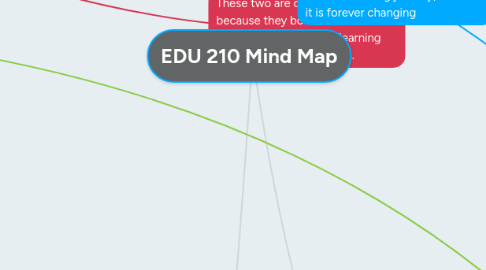EDU 210 Mind Map
von Cheyenne Cardinal-Marten


1. ISTE Standards for Teachers 2008
1.1. Facilitate and Inspire Learning and Creativity-Teachers will use technology to help students advance their learning, and will create an environment for creative and innovative learning. Teachers will ensure the students will be exploring real-world issues, and come up with solving the problems collectively using technology. Self-reflection will be expected of the students, where they can use their digital tools to plan, think, and understand concepts. The teachers will also be learning with the students, their colleagues, and other digital interactions with others.
1.2. Design/ Develop Digital Age Learning Experiences-Teachers will use new digital technology to design and maximize learning. The teachers will use this technology to promote student creativity, and create a learning environment where the students can explore their curiosities. The teachers can also set their own education goals, and assess their own progress. Teachers will use the contemporary technology to address to the students diverse learning strategies.
1.3. Promote Digital Citizenship-Teachers will be expected to understand societal issues, and promote ethical behavior. Teachers will be expected to teach safety, legal use of technology, and respect copyrights. The proper resources and digital tools will be used appropriately, and understand that technology is forever evolving. Teachers will know to promote responsible social interactions, and engage/ collaborate with colleagues and students.
1.4. Professional Growth and Leadership-Teachers are always trying to improve their teaching strategies. They use technology to try and improve their students learning and try to make it creative. They are strong leaders, who participate in communities where they also share their vision in the use of technology. They also are expected to research effective ways to use their digital tools, to support their students learning.
1.5. Digital Age Work and Learning-Teachers use their digital work and tools to represent a professional digital society. Teachers understand technology systems, and use the knowledge in a professional digital world. Collaboration with the students will be ensured, where these digital tools can be shared with the parents, peers, and digital community. Ideas will be communicated to the students, their parents, and colleagues through media formats. These digital tools will be used to analyze, and evaluate digital information.
2. Information and Communication Technology (ICT) Program of Studies
2.1. Students will learn how technology does impact their everyday lives and work spaces. They will also learn how to use these technology tools, and how to apply them to communicate, solve issues/ problem solve, and decision making.
2.2. Technology can be used to interact with colleagues, resolve problems, and come up with solutions to enhance learning. Analyzing and evaluating through technology is something students and teachers will need to learn how to use.
2.3. Students are expected to apply and practice this knowledge in their daily lives. Communicating is key for their success, along with decision making, and problem solving.
2.4. There are 4 ICT curriculum, general outcomes, specific outcomes, illustrative examples, and assessment framework. These certain skills will help the students identify what they are expected to know, and what skills and knowledge they will need to apply. Support in digital devices and courses through technology use will be offered.
2.5. Communicating, Inquiring, Decision Making, and Problem Solving- Students will use technology, and critically analyze information. Students will also learn organizational skills in their digital tools, and learn electronic research techniques. The students will learn how to investigate and solve problems.
2.6. Foundational Operations, Knowledge and Concepts- Students will understand technology, and be able to apply it to self, work, and society. Moral and ethical technology use will be expected of the students, and they will be able to use the digital tools to better understand the world.
2.7. Processes of Productivity- Students will be expected to demonstrate their understandings of using technology. They will also share how technology plays a role in their daily lives, school, and work. They also will practice the concepts when using technology, and safety. Students will learn how to operate these skills in using technology.
2.8. Process of Productivity- Students will be able to revise and edit through technology. They will also be able to organize, communicate, and navigate through multimedia. They will also learn how to integrate other various applications towards their usage in digital technology.
3. The Digital Age Work and Learning, and the Digital Learning Environments are connected, because they both want to maximize innovative learning through digital tools, and technology.
4. These are connected, because they both want the knowledge to be applied in everyday life.
5. These two are connected, because they promote technology use in the students and teaches everyday life.
6. These are connected, because they want the teachers and students to practice technology use to solve problems, and collaborate to resolve these issues.
7. ISTE Standards for Students
7.1. Digital Citizen-This teaches the students how to be a responsible technology user, how to be safe, and how to engage in ethical behavior. Students will learn how to manage and maintain their personal data, and secure their digital privacy.
7.2. Creative Communicator-Students will express themselves creatively using technological tools, and choose these tools for their projects. The students will also make authentic creative pieces, which can convey complex ideas. This can be anything from simulations, models, and visualizations. Then the students will present the creative pieces, and their message for their demographic.
7.2.1. Global Collaborator-Students will use technology tools to invigorate their learning, and collaborate to the local, national, and global state. Students will interact with many diverse cultures, and learn from each other effectively. Technology would be used to connect, and work with other groups of people. Students will also create a collective of projects with their fellow peers, and work towards a certain learning goal. They will learn how to explore local and global issues, and use technology to create effective solutions.
